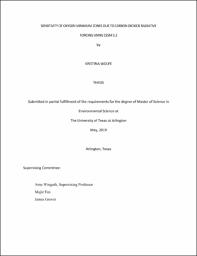
ATTENTION: The works hosted here are being migrated to a new repository that will consolidate resources, improve discoverability, and better show UTA's research impact on the global community. We will update authors as the migration progresses. Please see MavMatrix for more information.
Show simple item record
| dc.contributor.advisor | Winguth, Arne M. E. | |
| dc.contributor.advisor | Hunt, Andrew | |
| dc.creator | Wolfe, Kristina K. | |
| dc.date.accessioned | 2019-05-28T22:59:58Z | |
| dc.date.available | 2019-05-28T22:59:58Z | |
| dc.date.created | 2019-05 | |
| dc.date.issued | 2019-04-25 | |
| dc.date.submitted | May 2019 | |
| dc.identifier.uri | http://hdl.handle.net/10106/28163 | |
| dc.description.abstract | Anthropogenic-induced climate change is occurring at an unprecedented rapid rate, compared to the geologic past. In this study, CO2 stabilization scenarios (1x, 2x, and 4x preindustrial atmospheric pCO2 levels) utilizing the Community Earth System Model (CESM) are carried out to assess the response of oxygen minimum zones to net primary production and vertical carbon fluxes in a changing climate. Compared to the 1x CO2 experiment, sea surface temperature (SST) rise in the 4x CO2 scenario, to 3 °C to 5 °C in the Pacific and Atlantic Ocean, between 30 °S and 60 °S. In contrast, the North Atlantic Ocean and around Greenland cools by 6.5 °C which is linked to the weakening of the Atlantic meridional overturning circulation (AMOC). In the 4x scenario, export production decreases in the northern Atlantic Ocean, consistent to the cooling and reduced AMOC, and in the central equatorial Atlantic and Pacific Ocean, due to reduced Ekman-induced upwelling and associated decline in surface nutrient concentration. In contrast, export production increases in the region of the Antarctic Circumpolar Current (ACC), linked to a rise in surface phosphate (PO4) concentration. Surface nitrates (NO3) decrease globally, especially around the equator. Dissolved Oxygen (DO) concentration at intermediate depth of equatorial Atlantic and Pacific Ocean water masses decreases from 1x CO2 to the 4x CO2, linked to both a decrease in Apparent Oxygen Utilization (AOU) and decline in oxygen solubility by the warming. | |
| dc.format.mimetype | application/pdf | |
| dc.language.iso | en_US | |
| dc.subject | Oxygen minimum zone | |
| dc.subject | Carbon dioxide | |
| dc.title | SENSITIVITY OF OXYGEN MINIMUM ZONES DUE TO CARBON DIOXIDE RADIATIVE FORCING USING CESM 1.2 | |
| dc.type | Thesis | |
| dc.degree.department | Earth and Environmental Sciences | |
| dc.degree.name | Master of Science in Earth and Environmental Science | |
| dc.date.updated | 2019-05-28T23:01:03Z | |
| thesis.degree.department | Earth and Environmental Sciences | |
| thesis.degree.grantor | The University of Texas at Arlington | |
| thesis.degree.level | Masters | |
| thesis.degree.name | Master of Science in Earth and Environmental Science | |
| dc.type.material | text | |
| dc.creator.orcid | 0000-0003-0865-2786 | |
Files in this item
- Name:
- WOLFE-THESIS-2019.pdf
- Size:
- 5.573Mb
- Format:
- PDF
This item appears in the following Collection(s)
Show simple item record


